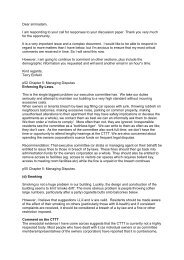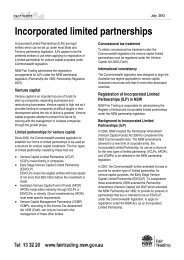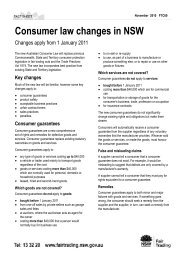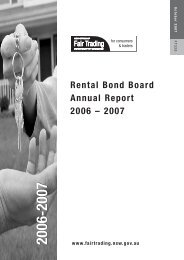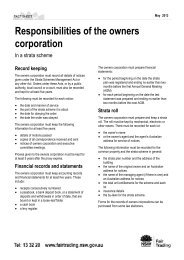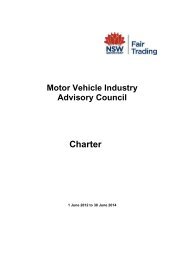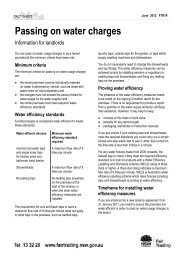High front guttering advisory committee report - NSW Fair Trading ...
High front guttering advisory committee report - NSW Fair Trading ...
High front guttering advisory committee report - NSW Fair Trading ...
You also want an ePaper? Increase the reach of your titles
YUMPU automatically turns print PDFs into web optimized ePapers that Google loves.
A similar confusion is found in the Australian Steel Institute’s information sheet in wrongly linking<br />
BCA “Acceptable Construction Practice” 2009 requirements for overflow measures with the need to<br />
meet AS/NZS 3500.3.2003 requirements in Appendix G. As stated in the previous paragraph, any<br />
implied exclusivity in this linkage is incorrect.<br />
Information on <strong>NSW</strong> <strong>Fair</strong> <strong>Trading</strong>’s website on residential gutters also creates confusion as it implies<br />
that compliance with the <strong>NSW</strong> Code of Practice for Plumbing and Drainage, which requires that all<br />
<strong>guttering</strong> be designed and installed in accordance with Australian/New Zealand Standard 3500.3<br />
sections 3,4 and part 5, will meet the relevant requirements of the BCA. As discussed above,<br />
AS3500.3 represents one way of meeting Deemed to Satisfy requirements in the BCA. Further, as<br />
discussed earlier in this <strong>report</strong> and as advised by <strong>NSW</strong> <strong>Fair</strong> <strong>Trading</strong>, compliance with the <strong>NSW</strong> Code<br />
of Practice for Plumbing and Drainage is more relevant to the regulatory framework for plumbing<br />
work that is regulated by water authorities and local councils, than to roof plumbing that is regarded<br />
as building and construction work and regulated under the BCA and Home Building Act 1989.<br />
As an over-arching comment concerning most of the above instances, there is a common trend to<br />
quote “informative” level information from AS3500 and as previously stated in this document, this<br />
level of information is for guidance rather than carrying the importance of “must do” status (i.e.<br />
“normative” level information). As a result, a number of the above mentioned publications are in<br />
the <strong>committee</strong>’s view inadvertently misleading practitioners. The information is also not well<br />
oriented to addressing the performance needs of high <strong>front</strong>ed <strong>guttering</strong> and this is disappointing<br />
given that these publications were apparently developed in order to address concerns about high<br />
<strong>front</strong>ed <strong>guttering</strong>.<br />
14 The Re-<strong>guttering</strong> Market<br />
This market is large - stakeholders suggest it represents between 65-86% of all <strong>guttering</strong> sales.<br />
Though such figures have not been validated by reliable sources of data, such claims hold validity on<br />
the basis that the vast majority of the overall building stock is made up of existing buildings.<br />
Accompanying this, gutters seldom last the full life of a building, hence replacement is somewhat<br />
inevitable. For instance the Cooperative Research Centre for Construction Innovation indicates that<br />
for many environmental categories, <strong>guttering</strong> is replaced at between 10-30 year periods (Predicted<br />
lifetimes of metallic building components, viewed on 1/2/11 at http://www.constructioninnovation.info/)<br />
and when extrapolated across the total housing stock of Australia, it is clear that<br />
the market is potentially much larger than the new dwelling market.<br />
An important issue here is that older buildings are quite likely to have been constructed from low<br />
<strong>front</strong> gutters that automatically provide for overflow that is directed away from entering the<br />
building. If such gutters are replaced with high <strong>front</strong>ed <strong>guttering</strong> then alternative overflow<br />
provisions may be required to prevent the 100 year ARI from entering the building. There is<br />
sufficient anecdotal evidence to have concern that in future, replacement <strong>guttering</strong> should not leave<br />
the building worse off in its ability to prevent water entry into the building than the old <strong>guttering</strong><br />
system – it should meet current BCA performance requirements (advice from Planning <strong>NSW</strong><br />
indicates that such <strong>guttering</strong> represents new work under the EP&A Regulation 2000 which calls up<br />
the BCA as the regulatory document to be followed for gutter design and construction).<br />
29



